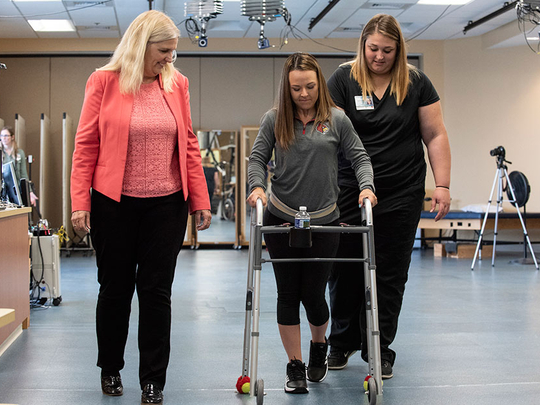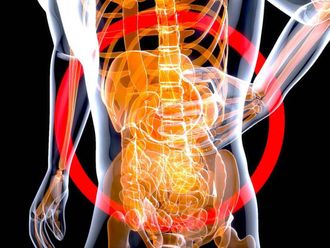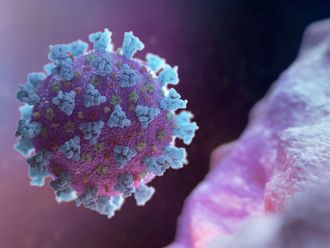
Louisville, Kentucky: A small group of paraplegic patients have once again been able to take steps after researchers implanted a device to electrically stimulate their spinal cords.
Two separate teams of scientists have revealed for the first time that the technique, together with physical training, has allowed three out of the five individuals treated to walk again after losing all voluntary movement below the site of the injury.
“It is incredible to be able to be in there and actually see them taking their first steps,” said Dr Claudia Angeli of Kentucky Spinal Cord Injury Research Centre at the University of Louisville, and a co-author of one of the studies. “It is an emotional time for the individual [themselves] because it is something that they have been told they are never going to be able to do again.”
In a study published in the New England Journal of Medicine, Angeli and colleagues report that they implanted an array of 16 electrodes in the lower back of four patients, paralysed after mountain bike or traffic accidents several years before. The device, originally developed many years ago for pain control, was placed below the site of injury, covering regions that send sensorimotor signals to the legs while a battery was implanted in the abdominal wall, allowing the frequency of the stimulation, its intensity and duration, to be tweaked wirelessly. Electrical activity produced by muscles in the legs was monitored during the sessions.
The approach — called epidural stimulation — works on the principle that there are still some small signals from the brain that cross the site of the spinal cord injury — even though these are not enough on their own to generate voluntary movement.
“We know the spinal cord has the ability to organise very detailed motor activity,” said Angeli. “But before the injury it was getting commands from the brain and it was getting information from the environment as well.”
The injury, she said, disrupts this. “The spinal cord is isolated, it potentially still receives information from the environment, but it is losing the big driver, which was the brain.”
Angeli said that it is thought that when the implanted device is turned on, the resulting electrical stimulation raises the excitability of the spinal cord — in a sense making it more alert.
“It is like it is more aware, it actually can listen to that little whisper from the brain that is still there and it can generate the motor pattern,” said Angeli, adding that training to link movements with these signals is crucial.
All four of the individuals had lost all motor control below the site of the injury, although two had some level of sensation.
After implantation of the device and locomotor training, the latter two were eventually able to walk over ground unassisted. One was able to walk after 81 sessions of stimulation over 15 weeks, although she had to use a walking frame, while the other was able to walk after 278 sessions over 85 weeks, requiring either parallel bars or holding people’s hands. In total he was able to walk just over 90 metres without a break.
The other two individuals became able to stand and sit independently and one was also able to make some stepping motions on a treadmill when supported — however the other sustained a spontaneous hip fracture after one week of training and only began training again a year later.
A separate paper by researchers from the Mayo Clinic in Minnesota and UCLA, published in the journal Nature Medicine, also reports success with the same approach. The team reveals that after 43 weeks of training with the implant a 29-year-old man, paralysed after a snowmobile accident and left with no sensation or voluntary motion below the injury, could walk without assistance on a treadmill — holding on to the rails — and across the ground, albeit with a moving frame and a little human assistance to maintain balance. He did not, however, regain sensation in his legs.
“The patient’s own mind, or thought, was able to drive the movement in the legs,” said Dr Kendall Lee of the Mayo Clinic, one of the principle investigators of the study, but he stressed much about the mechanism remains unknown.” You have to deliver a very specific type of stimulation parameters. A random stimulation does not work,” he added.
None of the individuals were able to achieve such actions when the stimulator was turned off.
Angeli said programming the device to give the best results takes time, and that there is a fine balance to be struck when tuning the intensity of the stimulation. If it is too low, the brain signals will still not be “heard” while, if it is too high, it can trigger involuntary movement of the legs.
But she said there are hopes the approach could help with more than leg movement. “A future direction that we are actually starting right now is to see if we target the epidural stimulation for [the] bladder itself, if we can actually improve the bladder control.”
Prof Gregoire Courtine from the EPFL research institute in Switzerland, who was not involved in either study, said he welcomed the research. But he said a key problem is that the current applied to the electrodes is continuous, meaning it can only be of low intensity — which may not result in the “whisper” from the brain being heard loudly enough by the legs. Courtine said he is working to solve this issue by synchronising the electrical stimulation with intended movements — his previous work in monkeys used brain implants to pick up on movement signals from the brain and send them to the legs, bypassing the site of injury and allowing a greater amplification of the signal to produce more robust muscle activity.
Mike Milner, CEO of the Nicholls Spinal Injury Foundation was also cautious, saying while the research looked promising, the charity supports another approach to tackle spinal injury using special cells taken from a patient’s nose, as well as nerve fibres, to patch the site of the injury.
“We are looking for not only a natural, or biological, cure for paralysis — but a permanent one,” he said.











